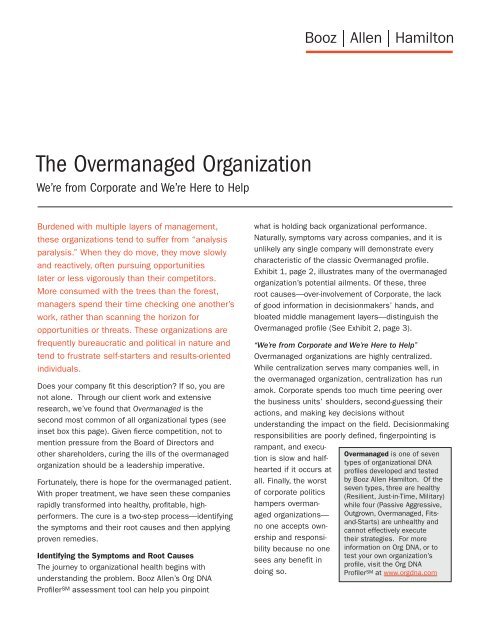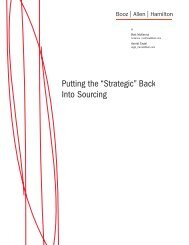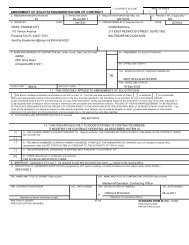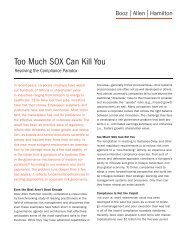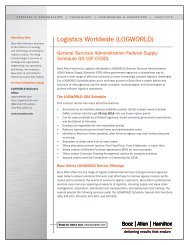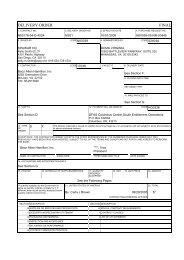The Overmanaged Organization - Booz Allen Hamilton
The Overmanaged Organization - Booz Allen Hamilton
The Overmanaged Organization - Booz Allen Hamilton
Create successful ePaper yourself
Turn your PDF publications into a flip-book with our unique Google optimized e-Paper software.
<strong>The</strong> <strong>Overmanaged</strong> <strong>Organization</strong><br />
We’re from Corporate and We’re Here to Help<br />
Burdened with multiple layers of management,<br />
these organizations tend to suffer from “analysis<br />
paralysis.” When they do move, they move slowly<br />
and reactively, often pursuing opportunities<br />
later or less vigorously than their competitors.<br />
More consumed with the trees than the forest,<br />
managers spend their time checking one another’s<br />
work, rather than scanning the horizon for<br />
opportunities or threats. <strong>The</strong>se organizations are<br />
frequently bureaucratic and political in nature and<br />
tend to frustrate self-starters and results-oriented<br />
individuals.<br />
Does your company fit this description If so, you are<br />
not alone. Through our client work and extensive<br />
research, we’ve found that <strong>Overmanaged</strong> is the<br />
second most common of all organizational types (see<br />
inset box this page). Given fierce competition, not to<br />
mention pressure from the Board of Directors and<br />
other shareholders, curing the ills of the overmanaged<br />
organization should be a leadership imperative.<br />
Fortunately, there is hope for the overmanaged patient.<br />
With proper treatment, we have seen these companies<br />
rapidly transformed into healthy, profitable, highperformers.<br />
<strong>The</strong> cure is a two-step process—identifying<br />
the symptoms and their root causes and then applying<br />
proven remedies.<br />
Identifying the Symptoms and Root Causes<br />
<strong>The</strong> journey to organizational health begins with<br />
understanding the problem. <strong>Booz</strong> <strong>Allen</strong>’s Org DNA<br />
Profiler SM assessment tool can help you pinpoint<br />
what is holding back organizational performance.<br />
Naturally, symptoms vary across companies, and it is<br />
unlikely any single company will demonstrate every<br />
characteristic of the classic <strong>Overmanaged</strong> profile.<br />
Exhibit 1, page 2, illustrates many of the overmanaged<br />
organization’s potential ailments. Of these, three<br />
root causes—over-involvement of Corporate, the lack<br />
of good information in decisionmakers’ hands, and<br />
bloated middle management layers—distinguish the<br />
<strong>Overmanaged</strong> profile (See Exhibit 2, page 3).<br />
“We’re from Corporate and We’re Here to Help”<br />
<strong>Overmanaged</strong> organizations are highly centralized.<br />
While centralization serves many companies well, in<br />
the overmanaged organization, centralization has run<br />
amok. Corporate spends too much time peering over<br />
the business units’ shoulders, second-guessing their<br />
actions, and making key decisions without<br />
understanding the impact on the field. Decisionmaking<br />
responsibilities are poorly defined, fingerpointing is<br />
rampant, and execution<br />
is slow and halfhearted<br />
if it occurs at<br />
all. Finally, the worst<br />
of corporate politics<br />
hampers overmanaged<br />
organizations—<br />
no one accepts ownership<br />
and responsibility<br />
because no one<br />
sees any benefit in<br />
doing so.<br />
<strong>Overmanaged</strong> is one of seven<br />
types of organizational DNA<br />
profiles developed and tested<br />
by <strong>Booz</strong> <strong>Allen</strong> <strong>Hamilton</strong>. Of the<br />
seven types, three are healthy<br />
(Resilient, Just-in-Time, Military)<br />
while four (Passive Aggressive,<br />
Outgrown, <strong>Overmanaged</strong>, Fitsand-Starts)<br />
are unhealthy and<br />
cannot effectively execute<br />
their strategies. For more<br />
information on Org DNA, or to<br />
test your own organization’s<br />
profile, visit the Org DNA<br />
Profiler SM at www.orgdna.com
2<br />
Exhibit 1<br />
Diagnosing the <strong>Overmanaged</strong> <strong>Organization</strong><br />
<br />
<br />
<br />
<br />
<br />
<br />
<br />
<br />
<br />
<br />
<br />
<br />
<br />
<br />
<br />
<br />
<br />
<br />
<br />
<br />
<br />
<br />
<br />
<br />
<br />
<br />
<br />
<br />
<br />
<br />
<br />
<br />
<br />
<br />
<br />
<br />
<br />
<br />
<br />
<br />
Source: <strong>Booz</strong> <strong>Allen</strong> <strong>Hamilton</strong><br />
Decisionmaking in the Dark<br />
In an overmanaged organization, decisionmaking rights<br />
reside at the top, but poor information flow means<br />
that Corporate leaders often make decisions in the<br />
dark. Under these conditions, those decisions tend to<br />
be reactive rather than proactive, with limited positive<br />
impact.<br />
Structural Woes<br />
Structural problems with far-reaching consequences<br />
plague the overmanaged organization. As cogs in<br />
rapid promotion cycles and believing that only vertical<br />
moves are true promotions, talented managers often<br />
vacate their positions before they have mastered them,<br />
missing the opportunity to understand those areas<br />
of the firm well. <strong>The</strong> resulting excessive management<br />
layers create a wide separation between top and<br />
bottom, impeding communication in both directions.<br />
In addition, micromanagement hinders timely<br />
decisionmaking.<br />
Curing the <strong>Overmanaged</strong> Patient<br />
We have found that treating these symptoms can transform<br />
overmanaged organizations into highly responsive<br />
players. However, just as different companies manifest<br />
different symptoms, different approaches to curing the<br />
overmanaged patient can be effective. <strong>The</strong> key lies in<br />
identifying and prioritizing the areas to address.<br />
First, develop a plan for the desired end state.<br />
Begin by assessing the company’s current state: its<br />
challenges, hypotheses about their causes, and a<br />
preliminary forecast<br />
of the solutions.<br />
Use benchmarking<br />
tools to validate<br />
the preliminary<br />
conclusions and to<br />
help guide a highlevel<br />
vision for the<br />
new operating model.<br />
Detailed design of the<br />
new organizational<br />
configuration follows.<br />
Finally, implementation<br />
of the carefully crafted<br />
solutions requires<br />
integrated change and<br />
program management,<br />
Our Data on the<br />
<strong>Overmanaged</strong> <strong>Organization</strong><br />
Of 25,000 responses to <strong>Booz</strong><br />
<strong>Allen</strong>’s <strong>Organization</strong>al DNA<br />
Profiler SM assessment tool, 16<br />
percent described <strong>Overmanaged</strong><br />
profiles. This diagnosis is most<br />
likely to be recognized by line<br />
managers—who suffer most<br />
acutely the “churn and burn” of<br />
the overmanaged organization.<br />
Although this profile is usually<br />
seen in companies with revenues<br />
ranging from $500 million<br />
to $1 billion, it nevertheless<br />
applies to firms of all sizes.<br />
<strong>The</strong> consequences of this ailment<br />
<strong>Overmanaged</strong> companies<br />
are most likely to be reported<br />
as “less profitable” than their<br />
rivals.
3<br />
Exhibit 2<br />
Profiler Analysis of <strong>Overmanaged</strong> Root Causes<br />
<br />
<br />
<br />
<br />
<br />
<br />
<br />
<br />
<br />
<br />
<br />
<br />
<br />
<br />
<br />
<br />
<br />
<br />
<br />
<br />
<br />
<br />
<br />
<br />
<br />
<br />
<br />
<br />
<br />
<br />
<br />
<br />
<br />
<br />
<br />
<br />
<br />
<br />
<br />
<br />
<br />
<br />
<br />
<br />
<br />
<br />
<br />
<br />
<br />
<br />
<br />
<br />
<br />
<br />
<br />
<br />
<br />
<br />
<br />
<br />
<br />
<br />
Source: <strong>Booz</strong> <strong>Allen</strong> <strong>Hamilton</strong> Org DNA Profiler SM . Total responses: 25,000<br />
including working with staff to help them adjust to their<br />
place in the new model and carefully timing the various<br />
initiatives.<br />
<strong>The</strong> second step varies, depending on the situation—<br />
we have seen two options succeed. Option 1<br />
attacks the structural problem first—excising middle<br />
management layers and using this reorganization to<br />
force changes in three other vital areas: information<br />
flow, decision rights, and motivators. This option works<br />
best when financial or shareholder pressure is strong,<br />
organizational impetus toward change is weak, or<br />
leadership already knows where excess staff capacity<br />
exists.<br />
Option 2 takes the opposite approach—focusing first<br />
on non-structural issues like information flows, decision<br />
rights, and incentive structures to reveal redundancies<br />
in the middle layers, allowing the subsequent<br />
restructuring to develop naturally. This option is most<br />
appropriate when the three driving conditions described<br />
in Option 1 are not in play. Another factor arguing for<br />
use of Option 2 is the existence of a robust way to<br />
monitor staff capacity utilization.<br />
With both options, the following three fundamental<br />
remedies will help put the overmanaged company on<br />
the road to organizational health.<br />
Reduce Layers and Increase Spans of Control<br />
Whether it is the first step of reorganization or the<br />
last, cutting layers and increasing spans of control are<br />
crucial to streamlining performance (see Exhibit 3).<br />
<strong>The</strong>se actions force clear definition of all organizational<br />
roles and decisionmaking authority, eliminate<br />
micromanagement, minimize bureaucracy, and reduce<br />
Exhibit 3<br />
Excessive Layers: Outlaw the Infamous “I”-Formation<br />
<br />
<br />
<br />
<br />
<br />
<br />
<br />
Source: <strong>Booz</strong> <strong>Allen</strong> <strong>Hamilton</strong>
4<br />
redundancies. One note of caution—such restructuring<br />
produces a profoundly different way of operating—<br />
managers should be well prepared and appropriately<br />
compensated for their new responsibilities.<br />
Classic Example: GE Medical 1<br />
GE Medical Systems in Milwaukee cut its order-toremittance<br />
time by 40 percent in 3 years by de-layering<br />
multiple times in the early 1990s. Serge Huot, VP of<br />
global sourcing in 1995, argued: “In a big organization<br />
each layer slows down the process. By de-layering, you<br />
are giving people the power to change.” For example,<br />
as a result of the de-layering in the X-Ray facility, only<br />
a production manager remained between the plant<br />
manager and 170 factory workers.<br />
Reconfirm or Reallocate Decision Rights<br />
Healing the overmanaged organization also requires a<br />
new approach to decisionmaking. Leaders must consider<br />
each decisionmaking situation separately, choosing<br />
between two approaches: reconfirming a fundamentally<br />
centralized decisionmaking process or reallocating<br />
decision rights more broadly throughout the company.<br />
In general, centralized decisionmaking is most appropriate<br />
for decisions involving strategic, financial, or customer<br />
risk. However, decisions that have primarily local<br />
impact on individual business units are candidates for<br />
re-allocation.<br />
Reconfirming centralized decision rights means reforming<br />
the organization so that both decisions and information<br />
align with the core of the organization, creating<br />
a strong, informed central leadership that employees<br />
can follow. Effective centralized decisionmaking<br />
depends on routing information consistently to decisionmakers<br />
at the Corporate level so they can make<br />
decisions that stick. Success results only if Corporate<br />
sets up motivational structures and policies to ensure<br />
buy-in from the field—line managers must have a<br />
reason to provide regular and reliable information to<br />
Corporate, and to execute Corporate’s decisions, not<br />
second-guess them. Once the model is up and running,<br />
Corporate must invest in succession planning and in<br />
grooming future decisionmakers.<br />
Another option is to decentralize decisionmaking by reassigning<br />
some decision rights lower in the hierarchy<br />
and defining new roles with clear accountability and<br />
ownership. Explicitly defining new roles will stamp<br />
out the second-guessing and frequent handoffs<br />
of responsibility that plague the overmanaged<br />
organization. Appointing process owners charged with<br />
cooperating horizontally across the organization will<br />
break down silos. However, new roles must be assigned<br />
thoughtfully, granting decision rights to the individuals<br />
with best access to all of the most relevant information.<br />
Whether reconfirming or reallocating decision rights,<br />
clearly defining the linkage between decisionmaking<br />
and business performance ensures employees know<br />
why they are doing what they are doing. Clear policies<br />
and guidelines, along with a performance assessment<br />
mechanism supported by metrics that clearly reflect<br />
the impact of decisions, show staff how their decisions<br />
matter. Tying the results of decisions to promotions<br />
and compensation provides further incentives. Finally,<br />
investing now in a leadership development program<br />
prepares employees to assume future decisionmaking<br />
roles.<br />
Classic Example: Taco Bell 2<br />
In an attempt to make his firm more customer<br />
focused, John Martin, CEO of Taco Bell, reengineered<br />
the organization, eliminating management layers<br />
and redefining the remaining jobs. For example, the<br />
district manager “supervisory” layer that used to oversee<br />
the management of 5-6 restaurants was cut, giving<br />
the restaurant managers autonomy to manage their<br />
$1-2 million businesses. <strong>The</strong> reengineering helped Taco<br />
Bell witness unprecedented sales & earnings growth.<br />
One of the key steps in helping the overmanaged<br />
patient recuperate is improving the flow of information<br />
within the organization. Here, it is important to<br />
distinguish between “data” and “information”—many<br />
overmanaged organizations are loaded with data<br />
but lack the high-quality information needed to<br />
drive effective decisionmaking. In fact, the impulse<br />
to overmanage often springs from insufficient or<br />
inaccurate information in the hands of decisionmakers,<br />
1<br />
Rahul Jacob, “<strong>The</strong> Struggle to Create an <strong>Organization</strong> for the 21st Century,” Fortune, April 3, 1995.<br />
2<br />
Michael Hammer & James Champy, Reengineering the Corporation, 1994.
5<br />
driving managers to double-check, second-guess, and<br />
reverse decisions. <strong>The</strong> result is the kind of “churn and<br />
burn” analysis paralysis, practiced mainly by middle<br />
management, that gets the organization nowhere fast.<br />
A variety of remedies can provide the overmanaged<br />
organization with the information it so vitally needs.<br />
Bridging communication gaps both vertically and horizontally<br />
represents a good start. Setting up reliable<br />
conduits of information between top and bottom is an<br />
essential part of the cure. In addition, communication<br />
horizontally across units can eliminate the silo effect<br />
that keeps so many employees uninformed. Experience<br />
shows that rewarding information and idea exchange<br />
motivates employees to find new ways to share<br />
throughout the company, across different divisions and<br />
functions.<br />
To facilitate good decisionmaking, it’s crucial that all<br />
key inputs reach decisionmakers on time and in a useful<br />
format—providing a 200-page report to a manager<br />
with a tight decision deadline doesn’t meet anyone’s<br />
needs. Easy information access—sometimes through<br />
an on-demand system—can ensure that all employees<br />
can get the information they need, when they need it.<br />
Finally, to foster employee ownership, tell everyone<br />
about the impact of their actions on the company’s<br />
bottom line—doing so can spur creativity and action,<br />
and exponentially raise the chances of success of any<br />
reform campaign.<br />
Classic Example: <strong>The</strong> New York Times 3<br />
When the HR organization of <strong>The</strong> New York Times<br />
realized that it needed an effective way to improve<br />
information sharing, it launched a weekly online<br />
newsletter that focused on HR “trends and internal<br />
business updates“ along with an interactive message<br />
board. In a feedback survey, 85 percent of employees<br />
said that the e-newsletter helped them “better<br />
understand the HR philosophy and the company’s<br />
strategic direction and to be more productive.” <strong>The</strong><br />
survey also found that “initiatives were implemented<br />
with increased speed as the new communications<br />
channels helped HR staff exchange information and<br />
collaborate quickly.”<br />
Next Steps<br />
<strong>Booz</strong> <strong>Allen</strong>’s extensive client experience suggests that<br />
systematic application of these and other remedies can<br />
cure the overmanaged organization, producing a new<br />
kind of company with more efficient information flows to<br />
drive decisionmaking and a more aligned organizational<br />
structure with fewer layers and clearer accountability.<br />
With the right treatment, overmanaged organizations<br />
can be transformed from slow-moving behemoths into<br />
lean, fast-moving competitors.<br />
3<br />
“Strategies for Making Manager-to-Employee Communication Count,” Managing Customer Service, July 1, 2004.
6<br />
What <strong>Booz</strong> <strong>Allen</strong> Brings<br />
Worldwide Offices<br />
<strong>Booz</strong> <strong>Allen</strong> <strong>Hamilton</strong> has been at the forefront of<br />
management consulting for businesses and governments<br />
for 90 years. <strong>Booz</strong> <strong>Allen</strong>, a global strategy and<br />
technology consulting firm, works with clients to<br />
deliver results that endure.<br />
With more than 16,000 employees on six continents,<br />
the firm generates annual sales of $2.7 billion. <strong>Booz</strong><br />
<strong>Allen</strong> provides services in strategy, organization,<br />
operations, systems, and technology to the world’s<br />
leading corporations, government and other public<br />
agencies, emerging growth companies, and<br />
institutions.<br />
To learn more about the firm, visit the <strong>Booz</strong> <strong>Allen</strong><br />
Web site at www.boozallen.com. To learn more<br />
about the best ideas in business, visit www.strategybusiness.com,<br />
the Web site for strategy+business,<br />
a quarterly journal sponsored by <strong>Booz</strong> <strong>Allen</strong>.<br />
Contact Information<br />
CHICAGO<br />
Gary Neilson<br />
Senior Vice President<br />
312-578-4727<br />
neilson_gary@bah.com<br />
BOSTON<br />
Eng-Ming Tan<br />
Principal<br />
617-428-4431<br />
tan_eng-ming@bah.com<br />
Deanna Mitchell<br />
Senior Associate<br />
312-578-4761<br />
mitchell_deanna@bah.com<br />
NEW YORK<br />
Decio Mendes<br />
Principal<br />
212-551-6612<br />
mendes_decio@bah.com<br />
Abu Dhabi<br />
Charles El-Hage<br />
971-2-6-270882<br />
Amsterdam<br />
Peter Mensing<br />
31-20-504-1900<br />
Atlanta<br />
Joe Garner<br />
404-659-3600<br />
Bangkok<br />
Tim Jackson<br />
66-2-653-2255<br />
Beijing<br />
Edward Tse<br />
8610-8520-0036<br />
Beirut<br />
Charles El-Hage<br />
961-1-336433<br />
Berlin<br />
Rene Perillieux<br />
49-30-88705-0<br />
Bogotá<br />
Jaime Maldonado<br />
57-1-628-5050<br />
Boston<br />
Dermot Shorten<br />
617-428-4400<br />
Brisbane<br />
Tim Jackson<br />
61-7-3230-6400<br />
Buenos Aires<br />
Ivan De Souza<br />
54-1-14-131-0400<br />
Caracas<br />
José Gregorio Baquero<br />
58-212-285-3522<br />
Chicago<br />
Chris Disher<br />
312-346-1900<br />
Cleveland<br />
Mark Moran<br />
216-696-1900<br />
Colorado Springs<br />
Glen Bruels<br />
719-597-8005<br />
Copenhagen<br />
Torsten Moe<br />
45-3393-36-73<br />
Dallas<br />
Tim Blansett<br />
214-746-6500<br />
Düsseldorf<br />
Thomas Kuenstner<br />
49-211-38900<br />
Frankfurt<br />
Rainer Bernnat<br />
49-69-97167-0<br />
Göteborg<br />
Anders Sewerin<br />
46-31-725-93-00<br />
Helsinki<br />
Kari Iloranta<br />
358-9-61-54-600<br />
Hong Kong<br />
Edward Tse<br />
852-2251-8892<br />
Houston<br />
Bob Lukefahr<br />
713-650-4100<br />
Jakarta<br />
Tim Jackson<br />
6221-577-0077<br />
Lexington Park<br />
Neil Gillespie<br />
301-862-3110<br />
London<br />
Shumeet Banerji<br />
44-20-7393-3333<br />
Los Angeles<br />
Tom Hansson<br />
310-297-2100<br />
Madrid<br />
Mercedes Mostajo<br />
34-91-411-8450<br />
McLean<br />
Eric Spiegel<br />
703-902-3800<br />
Melbourne<br />
Tim Jackson<br />
61-3-9221-1900<br />
Mexico City<br />
Alonso Martinez<br />
52-55-9178-4200<br />
Milan<br />
Enrico Strada<br />
390-2-72-50-91<br />
Munich<br />
Richard Hauser<br />
49-89-54525-0<br />
New York<br />
David Knott<br />
212-697-1900<br />
Oslo<br />
Karl Høie<br />
47-23-11-39-00<br />
Paris<br />
Bertrand Kleinmann<br />
33-1-44-34-3131<br />
Philadelphia<br />
Molly Finn<br />
267-330-7900<br />
Rio de Janeiro<br />
Paolo Pigorini<br />
55-21-2237-8400<br />
Rome<br />
Fernando Napolitano<br />
39-06-69-20-73-1<br />
San Diego<br />
Foster Rich<br />
619-725-6500<br />
San Francisco<br />
DeAnne Aguirre<br />
415-391-1900<br />
Santiago<br />
Leticia Costa<br />
562-445-5100<br />
São Paulo<br />
Letícia Costa<br />
55-11-5501-6200<br />
Seoul<br />
Jong Chang<br />
82-2-2170-7500<br />
Shanghai<br />
Edward Tse<br />
86-21-6100-1696<br />
Stockholm<br />
Torbjörn Kihlstedt<br />
46-8-506-190-00<br />
Sydney<br />
Tim Jackson<br />
61-2-9321-1900<br />
Tampa<br />
Joe Garner<br />
813-281-4900<br />
Tokyo<br />
Steve Wheeler<br />
81-3-3436-8631<br />
Vienna<br />
Helmut Meier<br />
43-1-518-22-900<br />
Warsaw<br />
Reg Boudinot<br />
48-22-630-6301<br />
Wellington<br />
Tim Jackson<br />
64-4-915-7777<br />
Zurich<br />
Jens Schädler<br />
41-1-20-64-05-0<br />
Downloadable digital versions of this article and other <strong>Booz</strong> <strong>Allen</strong> <strong>Hamilton</strong> publications are available from www.boozallen.com.<br />
09CP/1204 PRINTED in USA<br />
©2004 <strong>Booz</strong> <strong>Allen</strong> <strong>Hamilton</strong> Inc.


